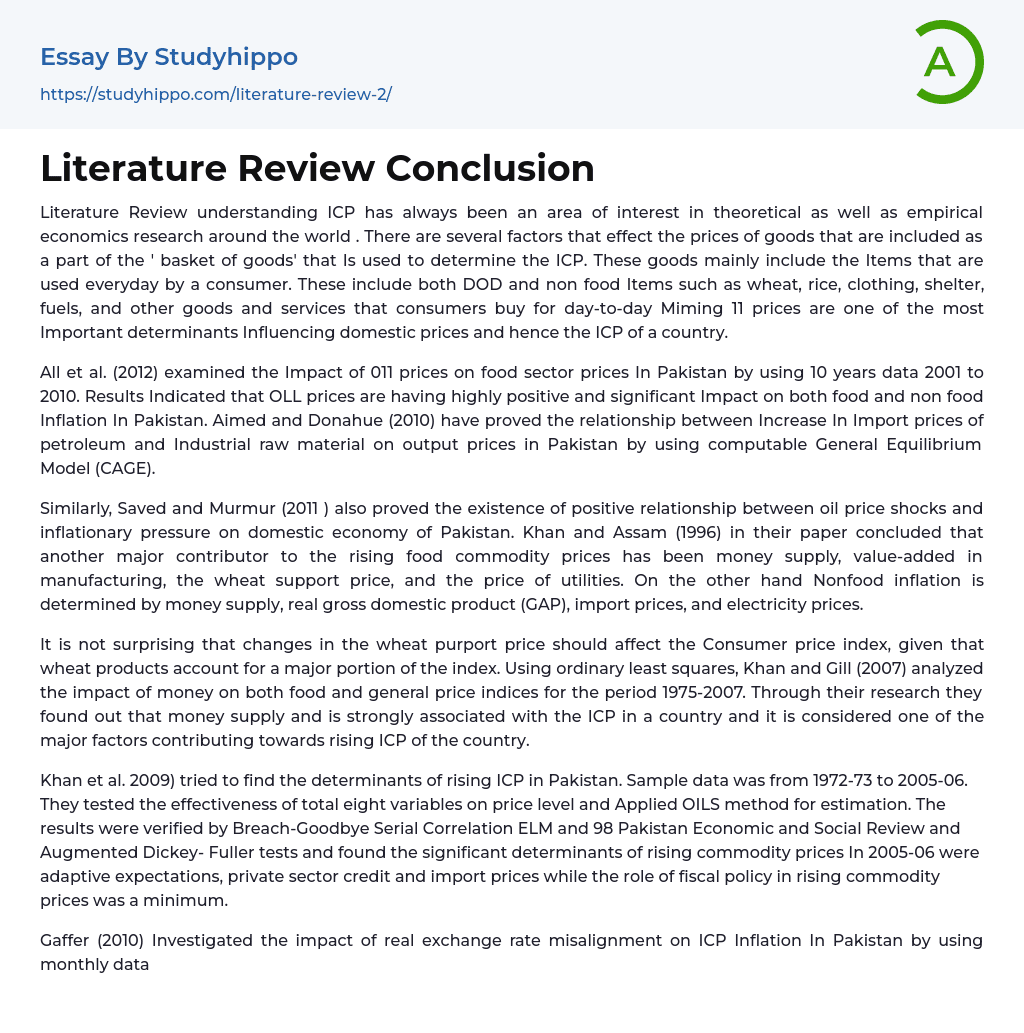Research conducted throughout the world, both theoretical and empirical, has long been interested in understanding ICP. The prices of goods that make up the "basket of goods" used to determine ICP are affected by several factors, mainly everyday consumer items such as wheat, rice, clothing, shelter, fuels, and other goods and services. Prices play a significant role in domestic prices and ultimately affect a country's ICP.
All et al. (2012) analyzed data from 2001 to 2010 to assess the impact of oil prices on food and non-food inflation in Pakistan. Results indicated a highly significant positive relationship between oil prices and inflation. Meanwhile, Aimed and Donahue (2010) demonstrated through the computable general equilibrium model (CAGE) that an increase in import prices of petroleum and industrial raw materials causes output prices to rise in Pakis
...tan. Similarly, Saved and Murmur (2011) found evidence to support a positive relationship between oil price shocks and inflationary pressure on Pakistan's domestic economy.
According to Khan and Assam (1996), the increase in food commodity prices can mainly be attributed to money supply, value-added in manufacturing, the wheat support price, and utility prices. Additionally, nonfood inflation is influenced by money supply, real gross domestic product (GDP), import costs, and electricity costs. The Consumer Price Index is impacted by changes in wheat support prices as wheat products constitute a significant portion of the index. In 2007, Khan and Gill conducted a study using ordinary least squares to examine the effect of money on food and general price indices from 1975-2007. They discovered that money supply has a strong correlation with the inflation rate, making it a major factor contributing to a
country's increasing inflation rate. In another research by Khan et al. (2009) on determining the factors leading to increasing inflation in Pakistan using data from 1972-73 to 2005-06 and applying the OILS method for estimation, results from Breach-Goodbye Serial Correlation ELM, Augmented Dickey-Fuller tests, and 98 Pakistan Economic and Social Review revealed adaptive expectations, private sector credit, and import costs to be significant determinants of rising commodity prices in 2005-06 while the effect of fiscal policy was minimal.In a study conducted by Gaffer (2010), the influence of real exchange rate misalignment on ICP inflation in Pakistan was explored using data from 1993-7 to 2010-3. The results revealed that foreign inflation has a significant effect on commodity prices, thus impacting the ICP of Pakistan. While misalignment was deemed insignificant for the overall period, it was found that overvaluation reduces inflation under a managed exchange rate regime, unlike a flexible exchange rate regime in Pakistan. In agreement with the 2008 study by Chapter and Richardson, higher commodity and energy costs play a major role in the increased commodity prices in the US. Similarly, as per the Asian Development Bank (2008) study, there is a reduced availability of stocks of corn, wheat, and soybeans worldwide due to the increased demand for food grains and edible oil in countries like China and India, causing a rise in food prices. Alongside this, Lounging and Swales (2001) have highlighted four contributing factors to increasing ICP and inflation in developing countries; these factors include demand pressures, supply shocks, inflation inertia, and fiscal and monetary policies.
External factors, including changes in exchange rates and foreign influences, significantly impact commodity prices and the International
Comparison Program (ICP). This effect is particularly evident in small open economies like Pakistan. Karma and Account (2010) noted the spillover effects of external factors such as changes in world prices on consumer price indices worldwide. Their study focused on Croatia, using seasonally adjusted quarterly data from 2000Q2 to 201 OSI. Using variance decomposition analysis with Vector Autoregressive (VARY) model, it was revealed that external shocks must be considered in theoretical modeling of domestic prices and economic activity. Moreover, Downed, A. (1985) carried out a study on the underlying causes of rising prices during 1960-77 and concluded that foreign factors, such as import prices, were the main driving force behind inflation in Barbados. In his study, he used econometric techniques with ICP regressed on the prime lending rate (interest rate), wage rate, and import price. Import price alone contributed to approximately 73% of total inflation during that period. Rammer et al. (2010) analyzed inflation, exchange rates, and interest rates' relationship for the period 1994 to 2009 in the UK and Pakistan by using time-series data.
The study utilized variables of interest rate differentials, exchange rate, and inflation differentials. Findings indicated a positive correlation between the inflation rates of the UK and Pakistan. This suggests that the price levels in the UK have a significant effect on prices, specifically the Consumer Price Index, in Pakistan.
- American Dream essays
- Barriers To Entry essays
- Capitalism essays
- Central Bank essays
- Compensation essays
- Consumerism essays
- Economic Development essays
- Economic Growth essays
- Economic Inequality essays
- Economic System essays
- Economy essays
- Employment essays
- Export essays
- Finance essays
- Free Trade essays
- Gross Domestic Product essays
- Human Development essays
- Income Inequality essays
- Industry essays
- Inflation essays
- International Business essays
- International Trade essays
- Macroeconomics essays
- Materialism essays
- Max Weber essays
- Microeconomics essays
- Minimum Wage essays
- Monetary Policy essays
- Monopoly essays
- Pricing essays
- Profit essays
- Recession essays
- resources essays
- Taxation essays
- Trade essays
- Unemployment essays
- Warehouse essays
- World economy essays
- American Literature essays
- Between The World and Me essays
- Book Report essays
- Book Review essays
- Book Summary essays
- Books essays
- Character essays
- Coming of Age essays
- Dante's Inferno essays
- Everyday Use essays
- Flowers for Algernon essays
- Genre essays




